Past Year Questions: Traffic Engineering | Transportation Engineering - Civil Engineering (CE) PDF Download
Q1: The consolidated data of a spot study for a certain stretch of a highway is given in the table.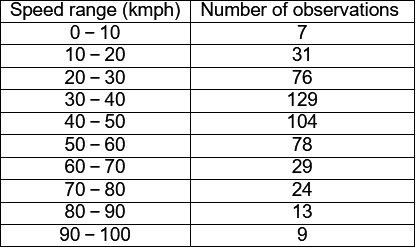
The "upper speed limit" (in kmph) for the traffic sign is (2024 SET-2)
(a) 50
(b) 55
(c) 65
(d) 70
Ans: (b)
Sol: 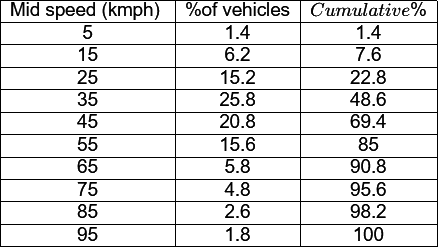 Hence 85th percentile speed or safe speed = 55 km/hrkm/hr
Hence 85th percentile speed or safe speed = 55 km/hrkm/hr
Q2: The figure presents the trajectories of six vehicles within a time-space domain. The number in the parentheses represents unique identification of each vehicle The mean speed (in km/hr) of the vehicles in the entire time-space domain is (rounded off to the nearest integer) (2024 SET-1)
The mean speed (in km/hr) of the vehicles in the entire time-space domain is (rounded off to the nearest integer) (2024 SET-1)
Ans: 52 to 58
Sol: Mean speed, Vt = Total distance/ Total Time
= 15.71 m/s
= 15.71 x (18/5) km/h
= 56.556 kmph
Q3: The free mean speed is 60 km/hr on a given road. The average space headway at jam density on the road is 8 m. For a linear speed density relationship the maximum flow (in veh/hr/lane) expected on the road is (2024 SET-1)
(a) 1875
(b) 938
(c) 2075
(d) 1038
Ans: (a)
Sol: Given, Free mean speed, Vf = 60kmph
Speed headway, s = 8 m
At jam density, k = kj = 1000/s = 1000/8 = 125veh/km
For linear speed density relationship,
Maximum flow, 

Q1: The figure presents the time-space diagram for when the traffic on a highway is suddenly stopped for a certain time and then released. Which of the following statements are true? (2023 SET-2)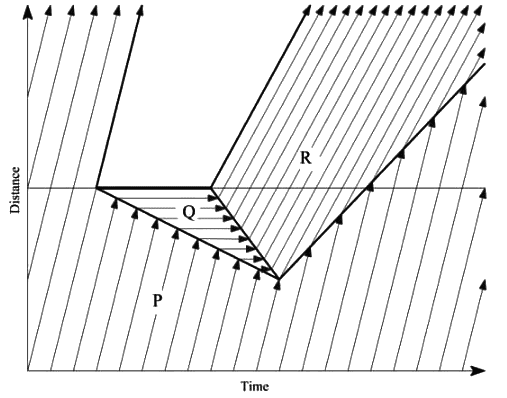 (a) Speed is higher in Region R than in Region P
(a) Speed is higher in Region R than in Region P
(b) Volume is lower in Region Q than in Region P
(c) Volume is higher in Region R than in Region P
(d) Density is higher in Region Q than in Region R
Ans: (b, c, d)
Sol: Any vertical line drawn in the graph which cuts arrow lines give positions of vehicles in different regions at a particular time.
Slope of a line in a region represents speed of vehicles in that particular region.
From the Plot :
- Distance between position of vehicles in region ' P ' is greater than that in region R⇒ Density in region ' P ' is greater than that in region ' R '.
- Slope of lines in region ' Q ' =0⇒ Speed of vehicles in region ' Q ' is zero.
- Slope of lines in region ' P ' is greater than in region ' R ' ⇒ speed of vehicles in region ' P ' is greater than in region ' R '.
- Since vehicles in region ' Q ' are stationary, flow or volume in region ' Q ' is zero and hence lower than in region P or region R. And density in region ' Q ' is higher than in region P or region R.
- Boundary between region ' P and ' R ' represents 'forward moving slope wave' means slope is positive.
i.e. slope = (qR−qP)/(KR−KP) > 0
q - Flow
K - Density
Since KR > KP
⇒ qR should be greater than qP.
⇒ Volume/flow in region ' R ' is higher than in Region 'P'.
Q2: A plot of speed-density relationship (linear) of two roads (Road A and Road B ) is shown in the figure.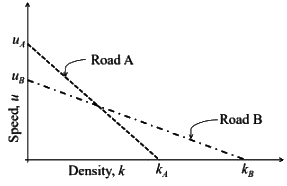
If the capacity of Road A is CA and the capacity of Road B is CB, what is CA/CB? (2023 SET-1)
(a) kA/kB
(b) uA/uB
(c) kAuA/kBuB
(d) kAuB/kBuA
Ans: (c)
Sol: For, Road 'A':
vf = uA, kj = kA
cA = Capacity of road,
For Road 'B':
vf = Free flow speed = uB
kj = Jam density = kB
Capacity of Road 'B' (cB) = uBkB/4
Q1: The lane configuration with lane volumes in vehicles per hour of a four-arm signalized intersection is shown in the figure. There are only two phases: the first phase is for the East-West and the West-East through movements, and the second phase is for the North-South and the South-North through movements. There are no turning movements. Assume that the saturation flow is 1800 vehicles per hour per lane for each lane and the total lost time for the first and the second phases together is 9 seconds.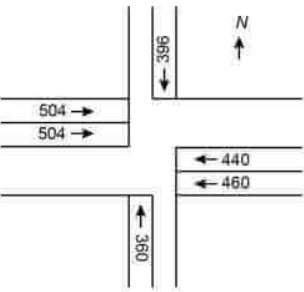 The optimum cycle length (in seconds), as per the Webster's method, is ____________. (round off to the nearest integer) (2022 SET-2)
The optimum cycle length (in seconds), as per the Webster's method, is ____________. (round off to the nearest integer) (2022 SET-2)
Ans: 37 to 37
Sol: From figure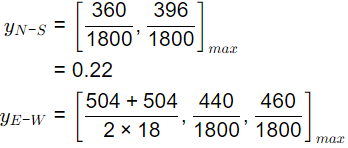
= 0.28
Optimum cycle length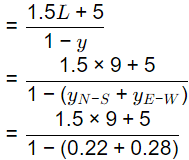
C0 = 37 secs.
Q2: Assuming that traffic on a highway obeys the Greenshields model, the speed of a shockwave between two traffic streams (P) and (Q) as shown in the schematic is _______ kmph. (in integer) (2022 SET-2) Ans: 15 to 15
Ans: 15 to 15
Sol: Speed of shock wave = Change in flow/Change in density
Flow = Speed × Density
Density = Flow/speed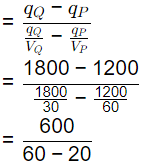
= 15Kmph
Q3: A single-lane highway has a traffic density of 40 vehicles/km. If the time-mean speed and space-mean speed are 40 kmph and 30 kmph, respectively, the average headway (in seconds) between the vehicles is (2022 SET-2)
(a) 3
(b) 2.25
(c) 8.33 x 10-4
(d) 6.25 x 10-4
Ans: (a)
Sol: Given that,
Traffic density = 40 Veh/Km.
Time mean speed = 40 Kmph
Space mean speed = 30 kmph
Time Headway (sec) = ?
We know that traffic volume
= Density x Space mean speed = 40 x 30 = 1200 Veh hr.
and we also know that
q = 3600/Ht
where Ht - average headway (sc)
1200 = 3600/Ht
Ht = 3600/1200 = 3 secs.
Q4: For a traffic stream, v is the space mean speed, k is the density, q is the flow, vf is the free flow speed, and kj is the jam density. Assume that the speed decreases linearly with density.
Which of the following relation(s) is/are correct? (2022 SET-2)
(a) q = kjk − (kj/vf) k2
(b) q = vfk − (vf/kj)k2
(c) q = vfv − (vf/kj)v2
(d) q = kjv − (kj/vf) v2
Ans: (b, d)
Sol: As per Greenshield's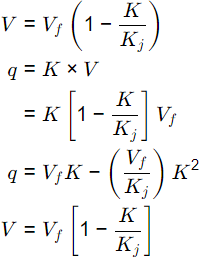
From above equation we can say that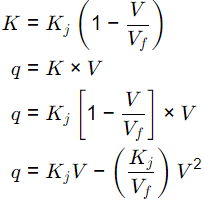
Q5: For the dual-wheel carrying assembly shown in the figure, P is the load on each wheel, a is the radius of the contact area of the wheel, s is the spacing between the wheels, and d is the clear distance between the wheels. Assuming that the ground is an elastic, homogeneous, and isotropic half space, the ratio of Equivalent Single Wheel Load (ESWL) at depth z = d/2 to the ESWL at depth z = 2s is ___________. (round off to one decimal place) (Consider the influence angle to be 45º for the linear dispersion of stress with depth) (2022 SET-1)
Ans: 0.5 to 0.5
Sol: ESWL @ depth d/2 = P
ESWL @ depth 2S = 2P
Ratio (P/2P) = 0.5
Q6: At a traffic intersection, cars and buses arrive randomly according to independent Poisson processes at an average rate of 4 vehicles per hour and 2 vehicles per hour, respectively. The probability of observing at least 2 vehicles in 30 minutes is ______. (round off to two decimal places) (2022 SET-1)
Ans: 0.78 to 0.82
Sol: λC = 4 vehical/hr = 2 vehical/30min
λC = 2 vehical/hr = 1 vehical/30min
λVehical = 3 vehical/30 min
P(x < 2) = 1 - P(x ≤ 1)
= 1 − [P(x = 0) + P(x = 1)]
= 1 - e-3 (1 + 3)
= 1 - (4/(e3))
= 0.8
Q7: A two-phase signalized intersection is designed with a cycle time of 100 s. The amber and red times for each phase are 4 s and 50 s, respectively. If the total lost time per phase due to start-up and clearance is 2 s, the effective green time of each phase is ______s. (in integer) (2022 SET-1)
Ans: 48 to 48
Sol: Two phase signalized intersections,
Cycle time = 100 secs.
Amber time = 4 secs. [each phase]
Red time = 50 secs. [each phase]
Total lost time = 2 sec. [each phase]
Effective green time = ? [each phase]
Total Effective green = Cycle time - Lost time = 100 - 2 x 2 = 96 sec.
As there is symmetry in phases so effective green time per phase = 96/2 = 4 8 sec.
Q8: Consider the four points P, Q, R, and S shown in the Greenshields fundamental speed-flow diagram. Denote their corresponding traffic densities by kP, kQ, kR and kS respectively. The correct order of these densities is (2022 SET-1)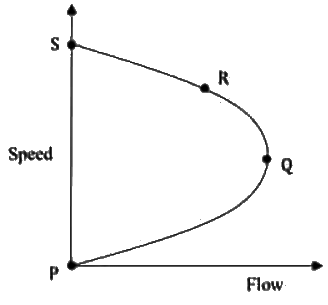
(a) kP > kQ > kR > kS
(b) kS > kR > kQ > kP
(c) kQ > kR > kS > kP
(d) kQ > kR > kP > kS
Ans: (a)
Sol: 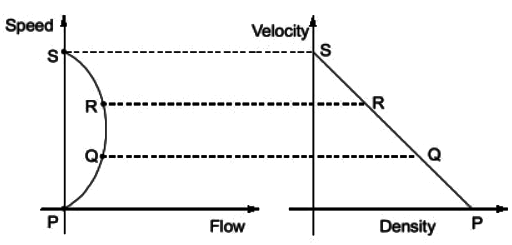
Q1: In a three-phase signal system design for a four-leg intersection, the critical flow ratios for each phase are 0.18, 0.32, and 0.22. The total loss time in each of the phases is 2s. As per Webster's formula, the optimal cycle length (in s, round off to the nearest integer) is _____ (2021 SET-2)
Ans: 48 to 52
Sol: L = 2 × 3 = 6 seconds
n = 3
y = (0.18 + 0.32 + 0.22)
= 50 seconds
Q2: Relationship between traffic speed and density is described using a negatively sloped straight line. If vf is the free flow speed then the speed at which the maximum flow occurs is (2021 SET-2)
(a) 0
(b) vf/4
(c) vf/2
(d) vf
Ans: (c)
Sol: Speed at maximum flow = Vf/2
Q3: Spot speeds of vehicles observed at a point on a highway are 40, 55, 60, 65 and 80 km/h. The space-mean speed (in km/h, round off to two decimal places) of the observed vehicles is ______ (2021 SET-1)
Ans: 55.5 to 58.5
Sol: V1 = 40, V2 = 55, V3 = 60, V4 = 65, V5 = 80
= 56.99 kmph
Q4: Vehicular arrival at an isolated intersection follows the Poisson distribution. The mean vehicular arrival rate is 2 vehicle per minute. The probability (round off to two decimal places) that at least 2 vehicles will arrive in any given 1-minute interval is _____ (2021 SET-1)
Ans: 0.58 to 0.6
Sol: P(n, t) = 
λ = 2v/m
t = 1 minutet = 1 minute
probability of at least 2 vehicles arriving in 1 ? minute is given by,
1 − (P(0, 1) + P(1, 1))
= 1 - (e-2 + 2e-2)
= 1 - 3e-2 = 0.59
Q5: A signalized intersection operates in two phases. The lost time is 3 seconds per phase. The maximum ratios of approach flow to saturation flow for the two phases are 0.37 and 0.40. The optimum cycle length using the Webster's method (in seconds, round off to one decimal place) is _______ (2021 SET-1)
Ans: 60.7 to 61.1
Sol: n = 2, L = 3 × 2 = 6sec
y1 = 0.37, y2 = 0.40
Y = y1 + y2
= 0.37 + 0.40
= 0.77
= 60.87 sec ≃ 60.9 sec
Q1: The flow-density relationship of traffic on a headway is shown in the figure. The correct representation of speed-density relationship of the traffic on this highway is (2020 SET-2)
The correct representation of speed-density relationship of the traffic on this highway is (2020 SET-2)
(a) 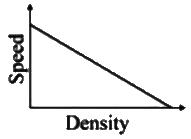
(b) 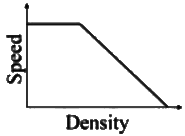
(c) 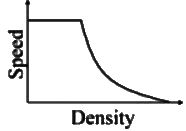
(d) 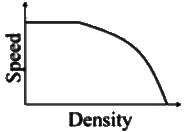
Ans: (c)
Q2: 24-h traffic count at a road section was observed to be 1000 vehicles on a Tuesday in the month of July. If daily adjustment factor for Tuesday is 1.121 and monthly adjustment factor for July is 0.913, the Annual Average Daily Traffic (in veh/day, round off to the nearest integer) is _______. (2020 SET-2)
Ans: 1021 to 1024
Sol: T24 = 1000 veh (Tuesday)
DAF = 1.121
AADT = ?
MAF = 0.913
Tweek = T24 x DAF
= 1000 x 1.121 = 1121
AADt = MAF x ADT
= 0.913 x 1121
= 1023.473
= 1023 V PD
Q3: The traffic starts discharging from an approach at an intersection with the signal turning green. The constant headway considered from the fourth or fifth headway position is referred to as (2020 SET-2)
(a) discharge headway
(b) effective headway
(c) intersection headway
(d) saturation headway
Ans: (d)
Q4: Traffic volume count has been collected on a 2 lane road section which needs upgradation due to severe traffic flow condition. Maximum service flow rate per lane is observed as 1280 veh/h at level of service 'C'. The Peak Hour Factor is reported as 0.78125. Historical traffic volume count provides Annual Average Daily Traffic as 122270 veh/day. Directional split of the traffic flow is observed to be 60 : 40. Assuming that traffic stream consists of 'All Cars' and all drivers are 'Regular Commuters', the number of extra lane(s) (round off to the next higher integer) to be provide, is ________. (2020 SET-1)
Ans: 6 to 6
Sol: Number of the needed given LOS = (DDHV)/(PHF × MSF × FHV × fp)
where,
DDHV = Directional distribution hour volume
PHF = Peak hour factor
MSF = Maximum service flow rate of Los
FHV = Heavy vehicle familiarity adjustment factor
fp = Road under familiarity adjustment factor
DDHV = 122270 x 0.6 = 7362 vah/day (0.6 - max. directional distributed)
FHV = fp = 1 as per given condition
N = (7362)/(0.78125 × 1280 × 1 × 1) = 7.362 = 8 lanes
Number of extra lanes = 8 − 2 = 6 lanes.
Q5: The relationship between traffic flow rate (q) and density (D) is shown in the figure. The shock wave condition is depicted by (2020 SET-1)
The shock wave condition is depicted by (2020 SET-1)
(a) flow with respect to point 1 (q1 = qmax)
(b) flow changing from point 2 to point 6 (q2 > q6)
(c) flow changing from point 3 to point 7 (q3 < q7)
(d) flow with respect to point 4 and point 5(q4 = q5)
Ans: (b)
Sol: 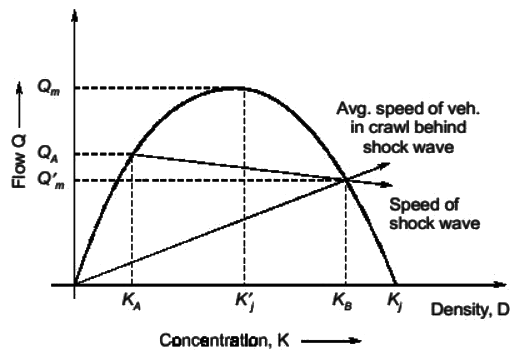
Q1: The speed-density relationship of a highway is given as u = 100 - 0.5k where, u = speed in km per hour, k = density in vehicles per km. The maximum flow (in vehicles per hour, round off to the nearest integer) is _____ [2019 : 2 Marks, Set-II]
Ans: 5000 to 5000
Sol:
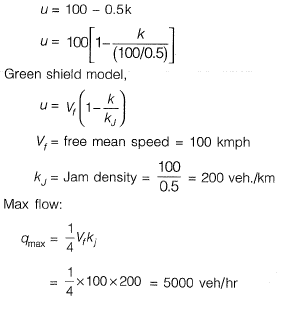
Q2: The uniform arrival and uniform service rates observed on an approach road to a signalized intersection are 20 and 50 vehicles/minute, respectively. For this signal, the red time is 30 s, the effective green time is 30 s, and the cycle length is 60 s. Assuming that initially there are no vehicles in the queue, the average delay per vehicle using the approach road during a cycle length (in s, round off to 2 decimal places) is______ . [2019 : 2 Marks, Set-II]
Ans: 12 to 13
Sol: Arrival rate = 20 veh/min
Service rate = 50 veh/min
R= 30 sec, G1 = 30 sec, Cycle length = 60sec
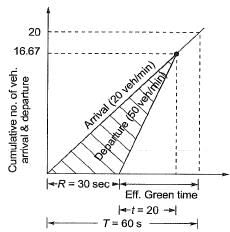
Time corresponding to which no. of arrival becomes same as no. of departure.
=> 20 x (R + t) =50t
20 x (30 + t) =50t
600 + 20t =50t


Q3: A vehicle is moving on a road of grade +4% at a speed of 20 m/s. Consider the coefficient of rolling friction as 0.46 and acceleration due to gravity as 10 m/s2. On applying brakes to reach a speed of 10 m/s, the required braking distance (in m, round off to nearest integer) along the horizontal, is [2019 : 1 Mark, Set-II]
Ans: 30 to 30
Sol:

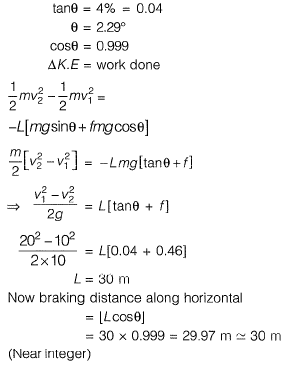
Q4: The speed-density relationship in a mid-block section of a highway follows the Greenshield's model. If the free flow speed is vf and the jam density is kj, the maximum flow observed on this section is (2019 SET-2)
(a) 
(b) 
(c) 
(d) 
Ans: (a)
Sol: 
Q5: Traffic on a highway is moving at a rate of 360 vehicles per hour at a location. If the number of vehicles arriving on this highway follows Poisson distribution, the probability (round off to 2 decimal places) that the headway between successive vehicles lies between 6 and 10 seconds is_______. [2019 : 2 Marks, Set-I]
Ans: 0.17 to 0.19
Sol:
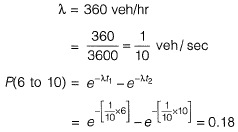
Q6: Average free flow speed and the jam density observed on a road stretch are 60 km/h and 120 vehicles/km, respectively. For a linear speed- density relationship, the maximum flow on the road stretch (in vehicles/h) is_______ , [2019 : 2 Marks, Set-I]
Ans: 1800
Sol:
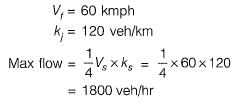
Q7: The maximum number of vehicles observed in any five minute period during the peak hour is 160. If the total flow in the peak hour is 1000 vehicles, the five minute peak hour factor (round off to 2 decimal places) is_______ . [2019 : 1 Mark, Set-I]
Ans: 0.51 to 0.53
Sol:

Q1: The space mean speed (kmph) and density (vehicles/km) of a traffic stream are linearly related. The free flow speed and jam density are 80 kmph and 100 vehicles/km respectively. The traffic flow (in vehicles/h, up to one decimal place) corresponding to a speed of 40 kmph is _________ [2018 : 2 Marks, Set-II]
Ans: 2000 to 2000
Sol: Vf - Free mean speed = 50 kmph
kj = Jam density = 100 veh/km
As per linear model (green-shield)
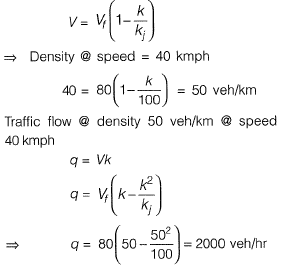
Q2: Peak Hour Factor (PHF) is used to represent the proportion of peak sub-hourly traffic flow within the peak hour. If 15-minute sub-hours are considered, the theoretically possible range of PHF will be [2018 : 1 Mark, Set-II ]
(a) 0 to 1.0
(b) 0.25 to 0.75
(c) 0.25 to 1.0
(d) 0.5 to 1.0
Ans: (c)
Sol:

Q3: A well-designed signalized intersection is one in which the
(a) crossing conflicts are increased
(b) total delay is minimized
(c) cycle time is equal to the sum of red and green times in all phases
(d) cycle time is equal to the sum of red and yellow times in all phases [2018 : 1 Mark, Set-I]
Ans: (b)
Q4: The speed-density relationship for a road section is shown in the figure [2018 : 1 Mark, Set-I]
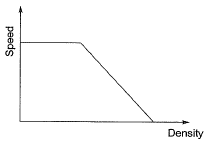
The shape of the flow-density relationship is
(a) piecewise linear
(b) parabolic
(c) initially linear then parabolic
(d) initially parabolic then linear
Ans: (c)
Sol:
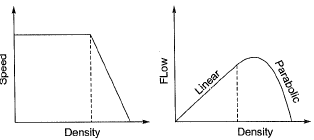
q = vk
For initial values of k, v is constant
∴ q will very linearly with k
Later on, v varies linearly with k.
∴ q will vary parabolically with k.
Q1: Two cars P and Q are moving in a racing track continuously for two hours. Assume that no other vehicles are using the track during this time. The expressions relating the distance travelled d (in km) and time t (in hours) for both the vehicles are given as
P : d=60t
Q : d = 60t2
Within the first one hour, the maximum space headway would be [2017 : 2 Marks, Set-II]
(a) 15 km at 30 minutes
(b) 15 km at 15 minutes
(c) 30 km at 30 minutes
(d) 30 km at 15 minutes
Ans: (a)
Sol: Space headway,
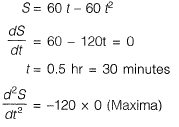

Q2: The safety within a roundabout and the efficiency of a roundabout can be increased, respectively by [2017 : 2 Marks, Set-II]
(a) increasing the entry radius and increasing the exit radius
(b) increasing the entry radius and decreasing the exit radius
(c) decreasing the entry radius and increasing the exit radius
(d) decreasing the entry radius and decreasing the exit radius
Ans: (c)
Q3: The queue length (in number of vehicles) versus time (in seconds) plot for an approach to a signalized intersection with the cycle length of 96 seconds is shown in the figure (not drawn to scale).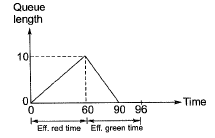
At time, t = 0, the light has just turned red. The effective green time is 36 seconds, during which vehicles discharge at the saturation flow rate, s (in vph). Vehicles arrive at a uniform rate, v(in vph), throughout the cycle. Which one of the following statements is TRUE? [2017 : 2 Marks, Set-I]
(a) v = 600 vph, and for this cycle, the average stopped delay per vehicle = 30 seconds.
(b) s = 1800 vph, and for this cycle, the average stopped delay per vehicle = 28.125 seconds.
(c) v = 600 vph, and for this cycle, the average stopped delay per vehicle = 45 seconds.
(d) s = 1200 vph, and for this cycle, the average stopped delay per vehicle = 28.125 seconds.
Ans: (b)
Sol: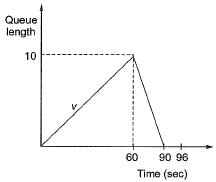
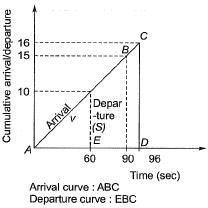
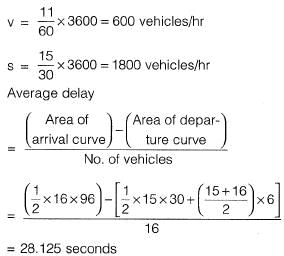
Q4: Vehicles arriving at an intersection from one of the approach roads follow the Poisson distribution. The mean rate of arrival is 900 vehicles per hour. If a gap is defined as the time difference between two successive vehicle arrivals (with vehicles assumed to be points), the probability (up to four decimal places) that the gap is greater than 8 seconds is __________. [2017 : 1 Mark, Set-I]
Sol: λ = 900 veh/hour
Probability that time gap (time headway) betwen successive vehicles is greater than 8 seconds,
Q1: The critical flow ratios for a three-phase signal are found to be 0.30, 0.25, and 0.25. The total time lost in the cycle is 10 s. Pedestrian crossings at the junction are not significant. The respective Green times (expressed in seconds and rounded off to the nearest integer) for the three phases are [2016 : 2 Marks, Set-II]
(a) 34, 28 and 28
(b) 40, 25, and 25
(c) 40, 30 and 30
(d) 50, 25, and 25
Ans: (a)
Sol: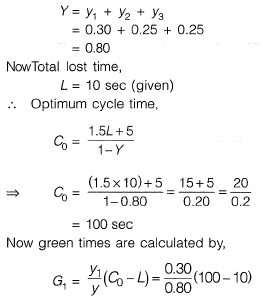
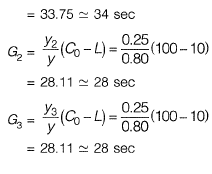
Q2: If the total number of commercial vehicles per day ranges from 3000 to 6000, the minimum percentage of commercial traffic to be surveyed for axle load is [2016 : 1 Mark, Set-II]
(a) 15
(b) 20
(c) 25
(d) 30
Ans: (a)
Q3: While traveling along and against the traffic stream, a moving observer measured the relative flows as 50 vehicles/hr and 200 vehicles/hr, respectively. The average speeds of the moving observer while traveling along and against the stream are 20 km/hr and 30 km/hr, respectively. The density of the traffic stream (expressed in vehicles/km) is________. [2016 : 2 Marks, Set-I]
Sol: Method-I
Let us assume,
q = traffic flow
k = traffic density
V = velocity of test vehicle along the stream
V - velocity of test vehicle against the stream
=> q - KVw =50
=> q - k x 20 = 50 ...(i)
q + kVa = 200
=> q + k x 30 = 200 ...(ii)
Solving equation (i) and (ii), we get
k = 3 Veh/km
Method-ll
Consider a ‘L’ km long stretch,
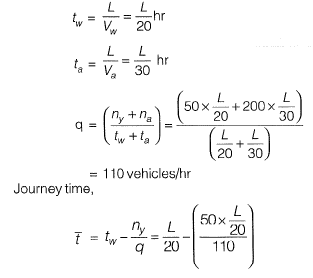
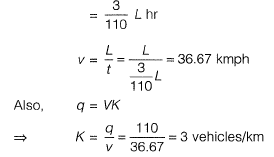
Q4: Inaone-lane one-way homogeneous traffic stream, the observed average headway is 3.0s. The flow (expression vehicles/hr) in this traffic stream is __________ [2016 : 1 Mark, Set-I]
Sol: Given: Average headway
= 3.0 sec
Flow of traffic stream

Q1: The relation between speed u(in km/h) and density k (number of vehicles/km) for a traffic stream on a road is u = 70 - 0.7k. The capacity on this road is ________ vph (vehicles/hour). [2015 : 2 Marks, Set-II]
Sol: Traffic volume,
q= uk
q= (70-0.7 k)k
= 70k-0.7 k2
Maximum possible volume is capacity of road
For maximum volume,
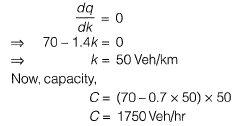
Q2: The following statements are made related to the lengths of turning lanes at signalised intersections
(i) 1.5 times the average number of vehicles (by vehicle type) that would store in turning lane per cycle during the peak hour.
(ii) 2 times the average number of vehicles (by vehicle type) that would store in turning lane per cycle during the peak hour.
(iii) Average number of vehicles (by vehicle type) that would store in the adjacent through lane per cycle during the peak hour.
(iv) Average number number of vehicles (by vehicle type) that would store in all lanes per cycle during the peak hour.
As per the IRC recommendations, the correct choice for design length of storage lanes is [2015 :1 Mark, Set-Il]
(a) Maximum of (ii) and (iii)
(b) Maximum of (i) and (iii)
(c) Average of (i) and (iii)
(d) Only (iv)
Ans: (c)
Sol: Design length is the average of (i) and (iii) as per Indian Roads Congress (IRC) recommendations for storage lanes.
Q3: Which of the following statements CANNOT be used to describe free flow speed (uf) of a traffic stream? [2015 : 1 Mark, Set-I]
(a) uf is the speed when flow is negligible
(b) uf is the speed when density is negligible
(c) uf is affected by geometry and surface conditions of the road
(d) uf is the speed at which flow is maximum and density is optimum
Ans: (d)
Sol: Free flow speed (Vf) is that speed at which flow and density is negligible.
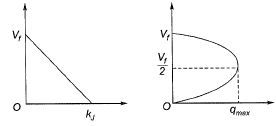
Q1: A pre-timed four phase signal has critical lane flow rate for the first three phases as 200, 187 and 210 veh/hr with saturation flow rate of 1800 veh/hr/lane for all phases. The lost time is given as 4 seconds for each phase. If the cycle length is 60 seconds, the effective green time (in seconds) of the fourth phase i s ________ . [2014 : 2 Marks, Set-II]
Sol: Flow rates for the first three phase are given as
q1 = 200 veh/hr
q2 = 187 veh/hr
and q3 = 210 veh/hr
Saturation flow rate is 1800 veh/hr/lane
Lost time,
L = 4 x 4 = 16 sec
Length of the cycle,
C0 = 60 sec
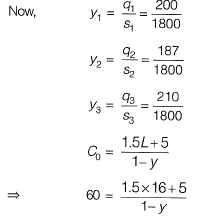
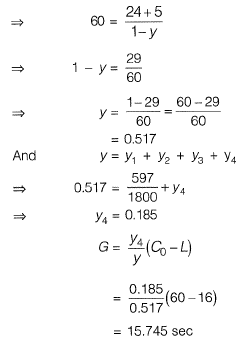
Q2: On a section of a highway the speed- density relationship is linear and is given by v = [80 - (2/3) k]; where v is in km/h and k is in veh/km. The capacity (in veh/h) of this section of the highway would be [2014 : 2 Marks, Set-II]
(a) 1200
(b) 2400
(c) 4800
(d) 9600
Ans: (b)
Sol: Method-I
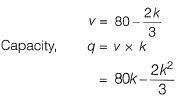
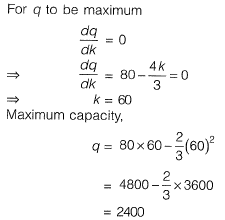
Method-II
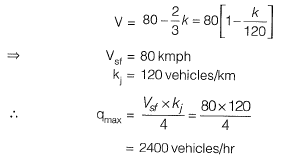
Q3: A student riding a bicycle on a 5 km one-way street takes 40 minutes to reach home. The student stopped for 15 minutes during this ride. 60 vehicles overtook the student (assume the number of vehicles overtaken by the student is zero) during the ride and 45 vehicles while the student stopped. The speed of vehicle stream on that road (in km/hr) is [2014 : 2 Marks, Set-II]
(a) 7.5
(b) 12
(c) 40
(d) 60
Ans: (d)
Sol: Method-I
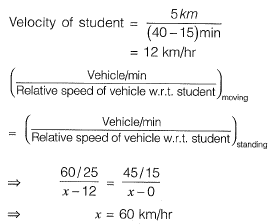
Method-I
45 vehicles overtook the student when he stopped for 15 minutes.
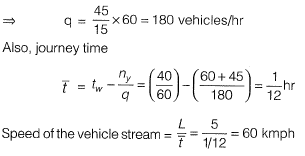
|
26 videos|102 docs|58 tests
|
FAQs on Past Year Questions: Traffic Engineering - Transportation Engineering - Civil Engineering (CE)
| 1. What are the key topics covered in Traffic Engineering for GATE exam preparation? |  |
| 2. How can I effectively prepare for the Traffic Engineering section of the GATE exam? |  |
| 3. What is the significance of traffic flow characteristics in Traffic Engineering? |  |
| 4. What are some common formulas used in Traffic Engineering? |  |
| 5. How is traffic signal timing determined in urban areas? |  |





















